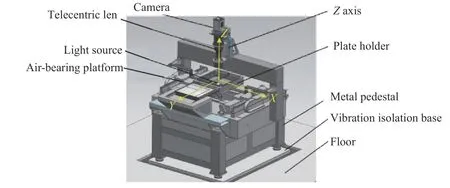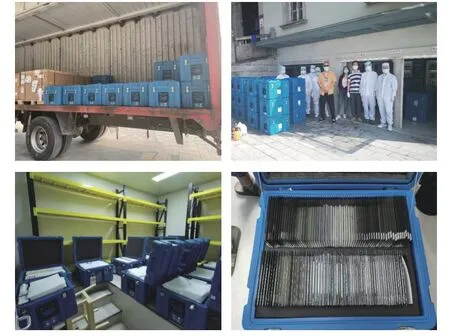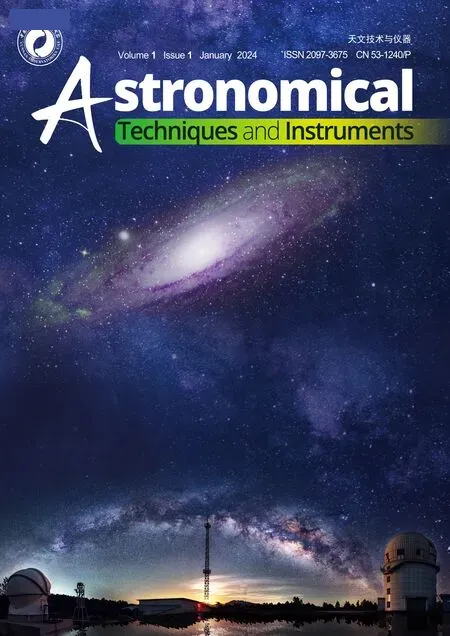Development and application of high-precision multifunction astronomical plate digitizers in China
Meiting Yang, Yong Yu,2*, Liangliang Wang, Zhengjun Shang, Changshun Liu, Lixin Zheng,Zhendong Chen, Jing Yang, Dongmei Da, Shan Dong, Shiyin Shen,Zhenghong Tang,2, Jianhai Zhao
1Shanghai Astronomical Observatory, Chinese Academy of Sciences, Shanghai 200030, China
2University of Chinese Academy of Sciences, Beijing 100049, China
Abstract: Before charge-coupled device detectors became widely employed in observational astronomy, for more than a hundred years, the main detection method was photography on astronomical glass plates.Recently, in order to preserve these historical data and maintain their usability, the International Astronomical Union has appealed to all countries for global digitization of astronomical plates by developing or adopting advanced digitization technology.Specialized digitizers with high precision and high measuring speed represent key equipment for this task.The Shanghai Astronomical Observatory and the Nishimura Co., Ltd in Japan cooperated between 2013 and 2016 to develop the first Chinese high-precision astronomical plate digitizer, which was then used for complete digitization of all nighttime-observation astronomical plates in China.Then, in 2019-2021, the Shanghai Astronomical Observatory independently developed new models of plate digitizers that enabled countries such as Uzbekistan and Italy to digitize their astronomical plates.Additionally, a new high-precision and multifunction digitizer was also used to digitize valuable microscope slides from the Shanghai Natural History Museum, providing a successful example of crossdomain application of high-precision digitization technology.
Keywords: Astrometry-instrumentation; Detectors-methods; Data analysis-techniques; Image processing
1.INTRODUCTION
Monitoring the movement and evolution of celestial bodies in the universe, at astronomical timescales,requires long-term observational data.Between 1850 and 2000, astronomical observations have been captured on approximately three million photographic plates by observatories worldwide[1], each plate representing an irreplaceable and unique observation record.These astronomical plates are an essential tool to extend modern observations backward in time and to study long-term variations of astronomical phenomena[2-4].
Once astronomical plates are scanned and digitized,the information they contain is more easily available for scientific research.Unfortunately, because of technological limitations, only a small fraction of the worldwide astronomical plate collection has been scanned, and often only partially; most plates have not yet been digitized.However, because astronomical plates are sensitive to ambient light, temperature, and humidity, they require strict preservation conditions, and their quality degrades with time.Therefore, they have been listed as an “endangered scientific data resource” by the Committee on Data of the International Science Council.In 2000, the International Astronomical Union (IAU) established the Preservation and Digitization of Photographic Plates(PDPP) working group, advocating for increased international cooperation between astronomers to accelerate astronomical plate data preservation.However, efficient but non-destructive digitization of astronomical plates is extremely difficult to achieve.Only a few astronomical observatories, such as the Harvard College Observatory[5], the Royal Observatory of Belgium[6],and the Paris Observatory[7]have successfully developed high-precision plate digitizers.This is markedly insufficient to ensure full digitization of the considerable worldwide collection of astronomical plates.
In response to the IAU call for the protection and digitization of astronomical plates, the Shanghai Astronomical Observatory, Chinese Academy of Sciences (Hereafter SHAO) established the Plate Digitization Project Group (HereafterPDPG) in 2009 to salvage and process the Chinese stock of astronomical plates.Specialized digitizers represent key equipment to accomplish such a task.Section 2 introduces the first specialized astronomical plate digitizer, a successful product of Sino-Japanese cooperation.Section 3 describes the new high-precision multifunction plate digitizer developed independently by the SHAO.Section 4 concludes the manuscript.
2.FIRST HIGH-PRECISION ASTRONOMICAL PLATE DIGITIZER IN CHINA(2017)
2.1.Development History
Between 2012 and 2017, the SHAO received support from the Ministry of Science and Technology of the People’s Republic of China for a fundamental research project aiming at comprehensive digitization of all Chinese astronomical plates.In the early stage, on the basis of the current status of Chinese astronomical plates and the necessary measurement accuracy, key technical requirements for a digitizer were defined: optical resolution of more than 2000 dots per inch (DPI), scanning area greater than 300 mm × 300 mm, positioning accuracy better than 1 µm, photometric accuracy better than 0.02 magnitude,and scanning time of less than 15 min.Tests of high-end commercial scanners (models V750 and 10000XL, Epson)showed that their positional and photometric errors could not fulfill the digitization requirements for astronomical plates.Therefore, a specialized astronomical plate digitizer must be developed[8].
Analyzing digitizers from the Harvard College Observatory and the Royal Observatory of Belgium, which exhibited the best performance worldwide in 2013, the PDPG selected the instrument concept of a linear array camera with linear motion guide rail to guarantee scanning accuracy while reducing the development cost.After evaluation of candidates for technology development, the Nishimura limited-liability company (Nishimura Co., Ltd,Japan, hereafter Nishimura) was selected to develop a digitizer specialized for astronomical plates, based on high-precision mechanical guide rails.The Nishimura was responsible for hardware manufacturing, while the SHAO was responsible for software system development, including systematic error correction and image processing.After two years of development and testing, the digitizer met the astronomical plate digitization requirements.This was demonstrated using an astronomical plate with a surface area of 300×300 mm2.The plate was repeatedly digitized and measured.Brightness repeatability was approximately 0.01 magnitude.Digitization was also conducted at different incident angles (0°, 90°, and 180°); final overall digitization errors were better than 0.7 µm, as evaluated by comparing the position residuals of common stars on images digitized at different angles.Finally, the duration of the entire digitization process for the 300×300 mm2plate was approximately 10 min[9].
In April 2016, the digitizer passed the acceptance review organized by the Ministry of Science and Technology, becoming the world’s third high-speed astronomical plate digitizer with micrometer-level accuracy.The digitizer was installed inside the Sheshan Astronomical Plate Library, where a constant temperature of 22 °C ± 0.5 °C and a constant humidity level of 50% ± 5% are maintained.To avoid vibrations caused by personnel movement during scanning, the digitizer was placed on a concrete pedestal implanted in the mountain rock and isolated from the outer floor, as shown in Fig.1.

Fig.1.First high-precision astronomical plate digitizer developed at the Shanghai Astronomical Observatory in collaboration with the Nishimura Co., Ltd.(Japan).
2.2.Applications to Nighttime-Observation Plates
In 2017, the PDPG applied his digitizer for all Chinese astronomical plates used to record nighttime observations (30,750 images).In November 2017, the PDPG was invited to report on this work at IAU Symposium 339[10],establishing China as the first country to achieve high-precision digitization of its domestic nighttime-observation astronomical plates.
3.NEW HIGH-PRECISION MULTIFUNCTION PLATE DIGITIZER (2021)
3.1.Development History
In 2018, the XXXth IAU General Assembly extended the IAU digitization efforts by passing its Resolution B3,calling for joint efforts “on preservation, digitization, and scientific exploration of historical astronomical data,” urging astronomical institutions around the world to accelerate the digitization of historical plates.In addition to astronomy, scientific fields such as remote sensing, medicine,and aerial photogrammetry have also preserved numerous historical photographic plates or specimen slides that urgently require high-accuracy digitization.In response to IAU and through the promotion of technology and resource sharing within the Chinese “Belt and Road Initiative,” the PDPG proposed to develop a new model of high-precision multifunction plate digitizer and initiated a plan to build a world-class plate digitization laboratory,soon supported by funding from the Shanghai Municipal Science and Technology Commission as one of its major projects.
In 2019, considering, on the one hand, the technical proficiency in digitizer development acquired during cooperation between China and Japan and, on the other hand,the necessity to solve problems encountered daily during the digitization process, the PDPG initiated independent research and development of an improved high-precision plate digitizer relying on air-bearing guide rail technology.
Compared with the first digitizer developed by the SHAO and the Nishimura, the new model implemented the following features:
(1) to improve the plate scanning speed, a “block scanning” method was adopted: the entire plate is divided into equal regions or sub-images, from which a linear array camera collects distinct signals.By precisely controlling the fixed-point plate motion, this method ensures that the splicing error of each sub-image remains within a permissible range;
(2) to conduct long-term continuous plate digitization,the motion platform was equipped with an air-bearing,rather than mechanical, guide rail.Air-bearing guide rail technology applies both dynamic and static gas pressure to achieve smooth and vibration-free movement of the carrier table on the guide rail.Its advantages are highly smooth movement, fast speed, low heat generation, and long service life, all of which comply with the required rapid motion guidance and high-precision positioning for astronomical plate digitization;
(3) to improve scanning efficiency, an automatic plate input-output device was designed to process (clamping and positioning) plates of different sizes;
(4) finally, to diversify applications to color and reflective digitization, as required in other scientific fields to digitize, for example, animal and plant specimens, or films and slides of geological minerals, the corresponding digitizing capabilities were added to the original monochromatic transmissive plate digitizer.
The new plate digitizer model is mainly composed of a scientific-grade CMOS camera, an optical telecentric lens, an LED light source, a two-axis air-bearing motion platform, a metal pedestal, and a detached base to isolate the platform from vibrations of the surrounding bedrock,as shown in Fig.2.In the digitizer room, a regulation system maintains constant temperature and humidity; an additional cover is attached to the digitizer to reduce the influence of indoor air turbulence on the air-bearing guide rail movement.Temperature and humidity in the scanning area are stabilized to better than ±0.1°C and ±5%,respectively.In the early stage of digitizer development,strict selection and testing were conducted for each component[11]and yielded the following results: the repeatable positioning accuracy of the two-axis air-bearing motion platform was better than 0.025 µm within an operational range of 350 mm × 350 mm; the relative stability of the LED light source was better than 0.000 8 magnitude over 10 min; the isolation performance of the vibration isolation base met "vibration criterion B" (VC-B,25 µm/s).

Fig.2.Schematic basic structure of the new high-precision digitizer model.
Here, we describe the operational mode of the plate digitizer.The carrier table mounted on the two-axis air-bearing motion platform moves by successive high-precision,two-dimensional steps within the operational plane.The LED light source illuminates the plate.The scientificgrade camera collects plate information through the optical telecentric lens at each step to achieve complete area scanning of the astronomical plate.Finally, image-stitching technology is used to form a digital image.Despite precise hardware design, processing, and assembly, the digitizer remains affected by systematic errors: lens pointing deviation, lens distortion, image scaling error, misalignment between the CMOS chip and the platform movement direction, and image stitching error.For each source of systematic error, the project team has designed detection and correction methods to ensure that the digitizer complies with the astronomical plate digitization requirements[12].
Development of a black-and-white transmission digitizer and a color multifunction digitizer was completed in December 2020 and June 2021, respectively.The devices are shown in Fig.3.Table 1 lists the main technical parameters of the first (SHAO-Nishimura) and of the two new(SHAO-only) types of plate digitizers currently operational and installed in the Plate Digitization Laboratory of the SheShanAstronomical Observatory.

Table 1.Main technical parameters for each type of plate digitizer currently installed in the plate digitization laboratory

Fig.3.New high-precision digitizers.(A) monochromatic transmissive digitizer.(B) color multifunction digitizer.
3.2.Digitizer Applications
3.2.1.Astronomical plate digitization for foreign countries
After successful development of the new digitizer models, the SHAO launched the “ Who contributes, who shares” initiative to promote the application of its new digitizer in countries that own astronomical plates and to provide a Chinese contribution to the preservation of the international astronomical heritage.Uzbekistan and Italy first expressed their interest in digitizing their national collections of astronomical plates to contribute to the international development of digital astronomical research.From 2020 to 2022, 13 918 astronomical plates from the Ulugh Beg Astronomical Institute in Uzbekistan and 7 281 from the Turin Astronomical Observatory in Italy were delivered in batches to the plate digitization laboratory (Fig.4).

Fig.4.Delivery and unpacking of astronomical plates from Uzbekistan and Italy.
In agreement with the international Uzbek and Italian laboratories, a standard protocol for astronomical plate scanning was established, including plate cleaning, illumination measurement, and scanning, as shown in Fig.5.Anhydrous alcohol was applied to the glass side of each plate to clean and remove stains and writing marks.Dust was removed from the emulsion side of the astronomical plate with a compressed air blower.The transparency of each astronomical plate is complex and unique; therefore,before scanning, plate transmittance was measured with a densitometer to calibrate the digitizer LED light value and ensure that the digitized image background value remained within the tolerance range (45 000 ADU).During the scanning process, the scanning area size and image filename were chosen to match the original size and number, respectively, of the astronomical plate.

Fig.5.Cleaning, photometric metering, and scanning of an astronomical plate.
At the time of writing, the scanning of approximately 21 180 astronomical plates from both countries has been completed.During this period, researchers from the Ulugh Beg Astronomical Institute and Chinese PDPG members collaborated on combining the scanned data from Uzbekistan astronomical plates with the Gaia DR3 star catalog as a reference to provide a high-precision(approximately 0.1 ″) and long-term (approximately 38 years) set of astrometric measurements to improve the orbital parameters of asteroids Pallas and Vesta[12].Finally, in 2023, to further promote international cooperation on digitization of astronomical plates, the SHAO signed cooperation agreements with several research institutions, including the University of Chile, the Algerian National Observatory, and the Argentinean National Observatory.The University of Chile has already sent two boxes of sample plates with different specifications for trial scanning.
3.2.2.Diversification of plate digitization technology
In addition to astronomy, several other scientific research fields have accumulated numerous historical photographic plates and specimen slides, which are also valuable historical materials requiring urgent digitization.Previous studies have reported that, in the 1980s, more than ten PDS microdensitometers were introduced into China,but their extremely low efficiency did not allow for successful digitization in related scientific fields[13].In 2021, the color multifunction digitizer was applied to specimen slides from the Shanghai Natural History Museum collection, as shown in Fig.6.In total, 5 646 specimens were digitized into high-precision images, providing fundamental information and technical support for future construction of digital museums.

Fig.6.(A)Microscope slides from rare animal specimens from the Shanghai Natural History Museum.(B) Example digitized image.
4.CONCLUSION
Astronomy is an observational science.Before the 1990s, astronomers used photographic glass plates to record the positions and evolution of celestial bodies;thus, astronomical photographic plates remain the only data source for long-timescale studies of astronomical phenomena.To preserve these valuable observational data and maintain their usability, the IAU has been inciting countries worldwide to develop and apply advanced technologies for complete digitization of the global astronomical plates collections.
From 2013 to 2016, the SHAO and the Nishimura company in Japan jointly developed the first Chinese high-precision astronomical plate digitizer.This device has enabled China to become the first country to achieve high-precision digitization of its complete nighttime observation astronomical plate collection.In 2019-2021, the SHAO independently developed new plate digitizers, and first applied cooperatively to scan the astronomical plate collections of Uzbekistan and Italy.On this basis, Argentina,Algeria, and Chile have also signed cooperation agreements to digitize their national collections, thereby expanding the international cooperation promoted by the IAU.Finally, applications of the new high-precision multifunction digitizer have been diversified to include digitization of valuable specimens from the Shanghai Natural History Museum, as a first conclusive demonstration of crossdomain application of high-precision digitization technology, with potential perspectives for other fields such as remote sensing, medicine, and geographic surveys.
Currently, under the guidance of the IAU PDPP working group, we are initiating a global effort for astronomical plate digitization that aims to fully apply big-data and artificial intelligence technologies to extract valuable scientific information from century-old astronomical plates and to conduct research on long-timescale astronomical phenomena.
ACKNOWLEDGEMENTS
This work was conducted with the financial support of the National Key Research and Development Program of China (Grant No.2021YFE0103400), of the Shanghai Science and Technology Commission through its Scientific Research Project program (Grant No.21511104100),and of the National Natural Science Foundation of China(Grant No.12073062).
AUTHOR CONTRIBUTIONS
Meiting Yang, Yong Yu and Jianhai Zhao conceived the idea and initiated the project.Meiting Yang and Liangliang Wang mainly wrote the manuscript and produced the Figs.Liangliang Wang and Zhengjun Shang conducted the data experiments.Changshun Liu, Lixin Zheng and Zhendong Chen conducted the optical and mechanical design.Jing Yang, Dongmei Da and Shan Dong edited the manuscript.Shiyin Shen and Zhenghong Tang provided algorithm support.Jianhai Zhao supervised the project.All authors read and approved the final manuscript.
DECLARATION OF INTERESTS
Zhenghong Tang is an editorial board member for Astronomical Techniques and Instruments and was not involved in the editorial review or the decision to publish this article.The authors declare no competing interests.
- 天文研究与技术的其它文章
- Review of artificial intelligence applications in astronomical data processing
- The Jiao Tong University Spectroscopic Telescope Project
- End-to-end computational design for an EUV solar corona multispectral imager with stray light suppression
- Characteristics and close-range exploration methods of near-Earth asteroid 2016HO3
- Design and analysis of an advanced thermal management system for the solar close observations and proximity experiments spacecraft
- Application and prospect of the fluid cooling system of solar arrays for probing the Sun

